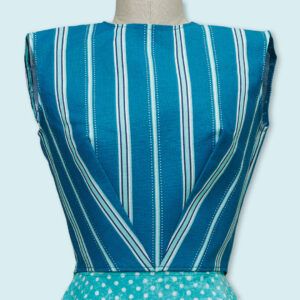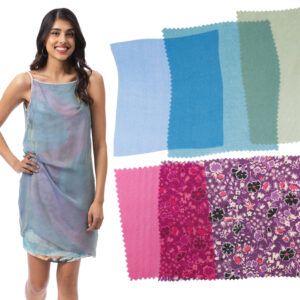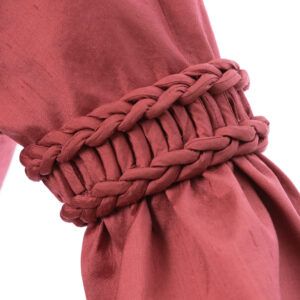I am making pants, and a shirt jacket out of dupioni silk, and I would like to interline the pants and top, since I am thinking the silk is a little thin without a lining. Would you recommend interlining, and if so, what kind of lining should I use? I am thinking I should pre handwash the silk before I start. I am new to this forum, and would like any help you can give me. Does the silk leave needle marks if you need to let out a seam?
Conversational Threads
Threads Insider
Get instant access to hundreds of videos, tutorials, projects, and more.
Start Your Free TrialAlready an Insider? Log in
Conversational Threads
Highlights
-
Sign up for the Threads eletter
This site is protected by reCAPTCHA and the Google Privacy Policy and Terms of Service apply.See all newsletters -
 Sponsored Content
Sponsored Content
Where to Buy
-

-

-

-























Replies
you need to experiment with several different underlinings to go with the dupioni, it depends on the drape you are after. Silk organza works very well, but you may want something a little softer like a fine cotton batiste, I have even used cotton flannel to underline it, Bemberger rayon makes a good lining.
Take a sample of each and hold them together with the silk and see how you like the drape and feel.
Judy
I think a cotton battiste would be good as its easy to come by , iscomfortable to wear and will improve the strength of your seams especially in the pants.Yes I would pre wash everything . The silk will become softer and I think nicer to wear. It will lose some of its lustre though.Given the expense of the fabric I would make a dummy run just so that you get the fit right . If you sew in silk thread that will help with the holes issue.There was a really good article about sewing with silk dupionie in Threads within the last 2 years or so.
Thank you, do you know if that article is archived on the website?
I would use a Bemberg rayon. It drapes really well and will keep your silk from bagging out in the knees and elbows. This was recommended to me at G Street Fabrics in the Wachington DC area.
Good luck!
Audrey Childress tended to err on the side of caution when it came to natural fibers. She preferred to underline silk with silk, linen with linen, etc. This is the surest guarantee that the "hand" of the top fabric will remain true. For example, her preference was to underline, say, a silk dupioni with a china silk, or a suit-weight linen with a tightly woven handkerchief linen. These are more than enough to support the stress associated with wear, preserve the structure of the garment, and help protect the top fabric from perspiration and body oils, which can permanently mar silks. Audrey's preference was NEVER to hand or machine wash pure silk (or linen, for that matter) because, as was mentioned, it loses its luster and draping qualities; she preferred to let the experts at the fabric mills manufacture laundered silk and the like prior to marketing. Hope this helps....Donna Childress Brandt, daughter of Audrey Childress
Edited 6/25/2005 9:05 am ET by DONNAKAYE
Donna,
I don't mean to sound rude here, but how about just your opinion? You sound very knowledgeable, I know you are very proud of your mothers achievements, I never took one of her classes but I know people who talk fondly of them, I'd love to hear your opinions on topics.Also, there is no harm whatsoever to underlining one type of fabric with a different fiber, I am making a dress of a silk /linnen blend and underlining it with a very fine cotton batiste, this is giving me the hand that I want, I don't' want to line the dress, I want a summer lightweight feel. I wouldn't want china silk - don't' like the way it feels, too cheap really, and the cotton gives that extra bit of absorbancy. a handkerchief linnen for the underlining would have been too heavy and add to the pressing woe's. I have used a lightweight cotton flannel to underline silk charmuse! its wonderful, gives you the luster and look of the charmuse but a much better hand for a dress. It all depends on what you are after in the finished project. As far as washing silk, I often do, coz I hate taking things to the dry cleaners, and linnen gets better and better each time you wash it, after x number of washes, it hardly needs to be ironed anymore. my favorite summer linnen dress (is now about 8 or 9 yrs old and is so soft and wonderful, the color (dark blue) has held up through many many washes.
Judy
You are absolutely one hundred percent correct, and Audrey would be the first to say so. The right underlining (or interlining, for that matter) is the right underlining FOR THE LOOK AND FEEL OF THE GARMENT. I don't think I ever heard Audrey teach that you should not or should never use a particular fabric or blend for a particular purpose. Accidents sometimes produce the most becoming result, and as we grew together as mother and daughter in the sewing room, we were often surprised at the results! Audrey never taught, nor is it my opinion, that there is any such thing as a "wrong" fabric choice. Sewing is an art form and, as such, necessitates experimentation; no two garments in my sewing studio are ever constructed exactly the same way. I can assure you that she chose, and of course I have chosen, fabrics for various garments that simply didn't turn out as hoped. Of course, I am slightly biased in favor of my mother's techniques, not because she was my mother but because they have proven over and over again to work so well. You will forgive me, I'm sure, for indulging in my mother's legacy in this regard.
I must tell you, I just LOVE the light flannel idea and I plan to try it on my next dupioni or shantung garment. Do allow me to make the observation that Audrey Childress lived in the New Orleans area; it gets well over 100 degrees here in the shade on any given summer day (and summer lasts a long, long time). Because we live in the deep south, a summer garment with a flannel under- or interlining would be absolutely unbearable (although I wish it weren't so, because the cotton flannel being so absorbent would make a great protection against perspiration and body oils). I would definitely try that for my fall, winter or spring garments. Your suggestion has prompted me to consider some lining or underlining fabrics that have wicking properties, such as is commonly used in active wear, and perhaps draw the wicking to the body side instead of the garment side to protect my silks. I have some of these lightweight wicking fabrics in my sewing room that I use for outdoor wear that I think I'll try on a shantung suit. If this works out well for the garment in this particular climate, I'll let everyone know.
Before signing off, please allow me to clarify my earlier comment on this thread. Audrey taught that, WHEN IN DOUBT as to how an underlining will affect the top fabric, the SAFEST course was to underlineline silk with silk, linen with linen, etc. Of course Audrey frequently underlined those fabrics with other both man-made and natural fibers; I have closets full of her garments in which that was done. Audrey's TEACHING methods were considered very carefully because of the fact that she had classrooms full of students and tried to more closely assure a successful outcome for the student in that class at that time, since together, teacher and student, they only made the garment once. She encouraged all of her students to go home after the class was concluded and experiment with fabric, color, design and the like. (When I address the group on a given topic, it's the "teacher" coming out in me.) Incidently, she designed almost all of her wardrobe herself and taught many, many classes in line and design.
One other thing, lest I forget to mention it: I am speaking of underlining here rather than interlining. Because of the climate, I rarely interline garments. (I do, however, interline coats and winter active wear.) But also because of the climate, I often underline garments for protection. I realize your initial post was speaking of interlining.
As for washing silks and linens, I have tried, but with disastrous results. How are you doing it?
I hope I am a little clearer on this posting than I seemed to be in the earlier one. My apologies if my communication was perhaps fuzzy or misunderstood. I'll keep your suggestion in mind for future posts, and I thank you for "setting me straight"!
Edited 6/26/2005 9:22 am ET by DONNAKAYE
Edited 6/26/2005 9:25 am ET by DONNAKAYE
Edited 6/26/2005 9:27 am ET by DONNAKAYE
Edited 6/26/2005 9:29 am ET by DONNAKAYE
Donna,
I got a good laugh out of thinking about the flannel in the summer, I live in Houston, our summers are just as bad as yours!- which is one of the reasons I'm putting the batiste in this dress, which btw, I HAVE NOT pre-washed this silk linen blend (the test scrap came out awful! and I don't pre-wash ALL silks, but anything for daily wear - to the grocery store type of stuff I do, and yes, I use silk for stuff like that too. I don't give it any special care, just throw the silk and linen in the washing machine with detergent. I looked up the terms underlining, and interlining in several of my books, what I refer to a underlining is often called "backings" in the industry and interlinings are what I normally refer to as interfacings. "a backing is an underply of material applied to the back of the shell, then the two parts are handled as one layer when the garment is assembled, in home sewing backings are called underlinings, in the industry they are also called mountings, flat linings, flattings, and sometimes even linings" this is from "SEWING FOR THE APPAREL INDUSTRY" By Claire Shaeffer, "Interlinings are an essential element in most garments, they are used to produce and retain the desired appearance and performance of the garment by adding support, body and shape. They are used to eliminate stretch and shadow proof seams, prevent sagging at necklines and button closures, stabilize and emphasize such details as collars, cuffs, waistbands etc..and add softness to hemlines"So, what I'm doing in this dress is actually what I have seen called a flat lining in one of Tautons books - you cut the lining or underlining a 1/2 inch wider at each vertical seam then,(so its actually one inch wider than the fashion fabric) sew the lining/fashion fabric right sides together with the edges matching then, turn the whole thing right side out and the lining wraps around the edge of the fashion fabric encasing the raw edges, the garment is then assembled. this gives the look of a Hong Kong finish but I find it much easier to do. it also provides more stability to the fashion fabric as an underlining or backing would provide but can eliminate the need for a separate lining if you use a lining type of material - rayon for instance.
I have never heard of that technique before, but I was working on a skirt yesterday where I happened to have cut the underlining bigger than the top fabric, so I'm going to try it down the center back of the skirt. Where can I get that book?
the book is called "Beyond the Pattern" and I just checked on Amazon and they do have it. IOts really a great book with lots of good information in it. I think its mostly a compilation of old articles from Threads magazine, but its well worth having
Judy
This post is archived.